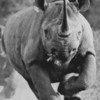I'm helping someone with his engine project. Its a low mileage 1973 Cobra Jet short block, dished pistons, originally 8:1 compression. The engine looks fairly good, the owner doesn't want to rebuild the engine, just freshen it up with rings & bearings. He wants to keep the engine looking stock, but pep-up the engine via compression and the camshaft. My first advice was to install TRW flat top pistons, but he wants to use the original dished pistons if possible. His reason is the head and valve train upgrades are expensive enough, without spending extra money on pistons. So I came up with a strategy to work within his limits:
I thought you guys might be interested in this uncommon solution to pepping-up the 1973/1974 Cobra Jet.
He's gonna replace the OEM D3ZE open chamber heads with D1AE quench heads, and mill the D1AE heads about 0.012", to set the chambers at 64cc. This will increase the engine's compression to 9.3:1. Then he'll augment that with a custom camshaft. The cam closes the intake valve 10° earlier than the norm for my projects, at 60° ABDC. The engine will build 7.7:1 dynamic compression with only 9.3:1 static compression. That is the same dynamic compression as an engine with 10:1 static compression, closing the intake valve at 70° ABDC. The camshaft has the same duration specs as the Cobra jet Cam, but 110° LSA. It pushes the overlap to what I consider the limit (for a street engine), and it has a bunch of lift. The overlap is centered very well around TDC, I've explained the benefits of this in the past.
I design cams based on valve events. I seldom spec a cam with 110° LSA, but I know cams with narrow LSA are popular with folks due to the media. So I figured you'd at least be interested in the cam. Reminds me of the cam in the Chevy LS7 corvette engine. Like the title says, its not your grandfather's cobra jet camshaft.
Custom Ground Camshaft via Bullet Cams
Hydraulic roller tappet camshaft
For a Ford 351C street engine
Intake Lobe #HR270/3533 @ 105° mathematic ℄
Exhaust Lobe #HR291/356 @ 115° mathematic ℄
_____________________________________
270°/291° duration at 0.006 (advertised)
216°/236° duration at 0.050
Hydraulic intensity = 54°/55°
0.611/0.616 theoretic valve lift (advertised)
0.603/0.607 net valve lift
LSA = 110°
The lobes are asymmetric,
“Max-lift” occurs before the lobes’ mathematic ℄
______________________________________
Seated valve events based upon advertised duration
EVO = 80.5° BBDC
IVO = 30° BTDC
Overlap = 60.5°
EVC = 30.5° ATDC
IVC = 60° ABDC **
_______________________________________
**Maximum compression ratio 9.29:1
Original Post


